#richard mabey
Photo

"The forest is not merely an expression or representation of the European spirit, but a fundamental element of it. The forest is both a symbol of tradition and a tangible expression of it, a physical reminder of the values and beliefs that have shaped Europe's history and culture for centuries."
- Richard Mabey
#Forest#Tejera Negra#beech forest#Richard Mabey#Europe#Tradition#European tradition#indo-europeans#religion#syncretism#forest's gods#ritual#symbols#carl jung#mircea eliade#sacred#sacred forest#celts#celtiberians#julius evola
25 notes
·
View notes
Text
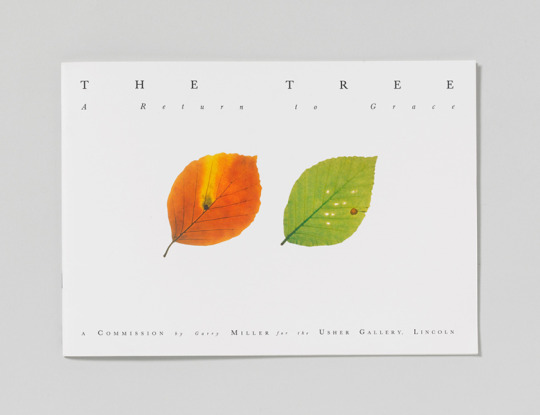
Garry Fabian Miller: 'The Tree', Essay by Richard Mabey and Chris Titterington, Usher Gallery, Lincoln, 1987 [© Garry Fabian Miller]

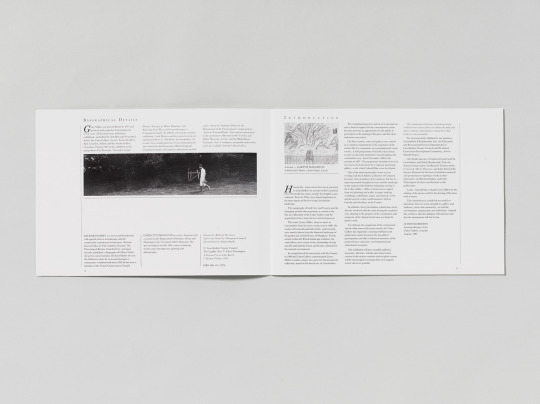
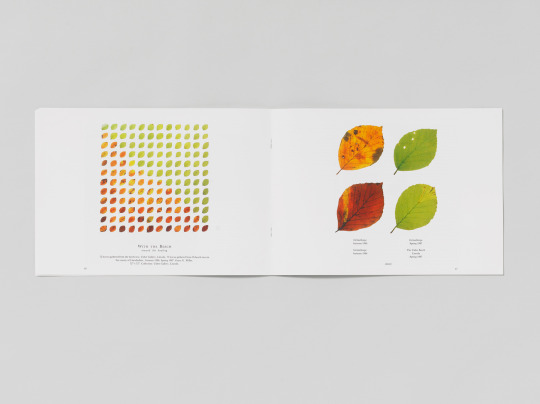
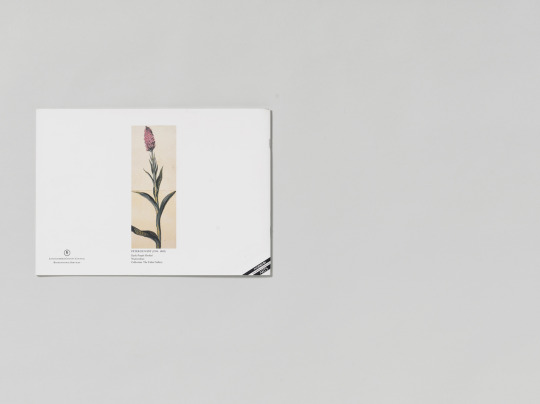
#graphic design#art#photography#catalogue#catalog#cover#back cover#garry fabian miller#richard mabey#chris titterington#usher gallery#1980s
11 notes
·
View notes
Text
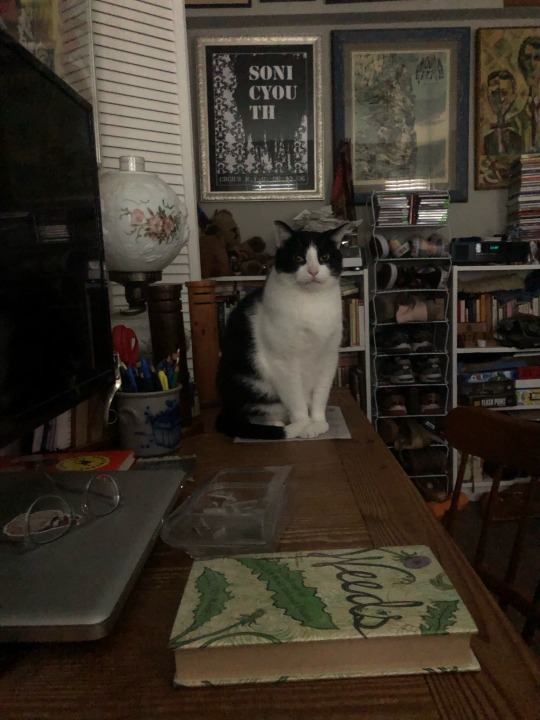
Stupid thing, but I’m really grateful that some of the re-blogs that I got overnight are for something other than Goncharov (1973). A little human connection in the morning is really nice to see. Thank you everybody. 
2 notes
·
View notes
Text
"A name, a colour, a smell, a season..." #richardmabey #theunofficialcountryside @LittleToller
As I mentioned in my end of February round up, I’m going to try to keep focused on the indies lurking on Mount TBR and today I wanted to share my thoughts about a book I’d fully intended to get to for #ReadIndies month – “The Unofficial Countryside” by Richard Mabey, published by Little Toller Books as one of their nature writing classics. LT are a firm favourite at the Ramblings, and I’ve…
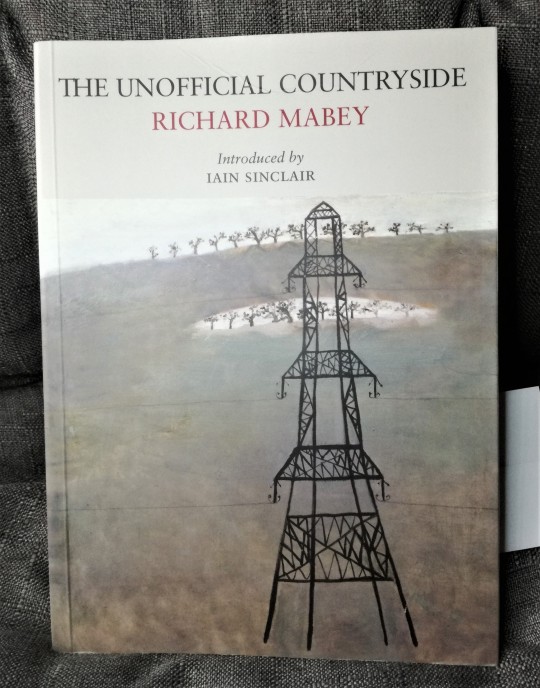
View On WordPress
0 notes
Text
okay i am incredibly sold on dungeon meshi
this is exactly how people react when i tell them you can eat hawthorn leaves
#WILD FOOD#he's basically holding Food for Free by Richard Mabey#do NOT trust that book it tells you you can eat gyromitra esculenta#you can if you like rocket fuel#(DO NOT EAT THAT)
4 notes
·
View notes
Text

OAK & COMPANY - written by RICHARD MABEY illustrated by CLARE ROBERTS
94 notes
·
View notes
Note
💜 richard horvitz? No way. I seamed like such a sweetheart. I saw a vid of him complementing someone's art in Zim's. Mabey you're right and he was having an off day but I hope I'm never mean to someone because of an off day. I do know Vasquez is an asshole though, since he joked about making a fan cry and tormenting Girs VA.
Yeah, it's hard to tell just from one encounter with someone. Maybe he acted the way he did because it wasn't a big convention and no cameras were rolling, maybe he was having an off day, could have been anything.
I've always wondered about Vasquez; he's tricky because it's hard to tell how much of him is his genuinely being an asshole and how much is playing up the persona. I...think the tormenting Rikki thing was a joke? I hope? But yeah, I know he's got no patience for what he perceives as any kind of fan nonsense, which is a recipe for disaster in a fandom like Invader Zim's.
7 notes
·
View notes
Photo

"Oak & Company" written by Richard Mabey and illustrated by Clare Roberts, 1983.
6 notes
·
View notes
Photo
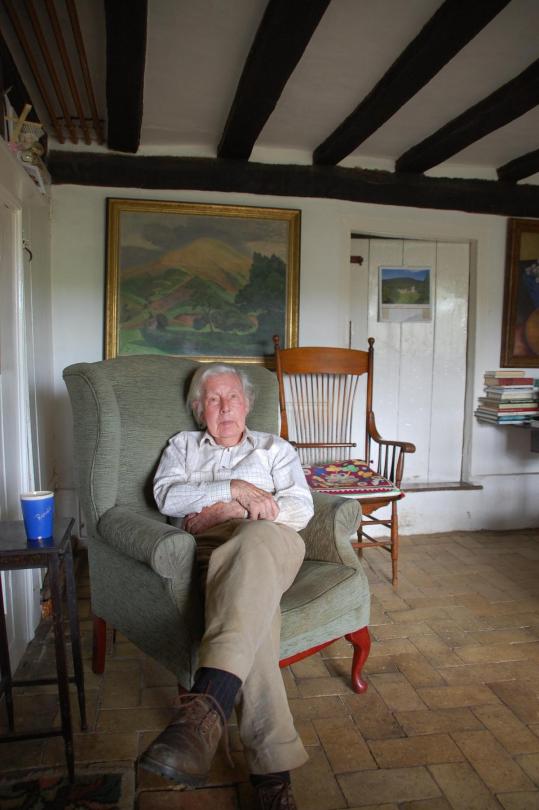
In the summer of 1967, Ronald Blythe cycled from his home in the Suffolk hamlet of Debach to the neighbouring village of Charsfield. There he listened to the voices of blacksmiths, gravediggers, nurses, horsemen and pig farmers. He gave them names from gravestones and placed them in a fictional village. Akenfield, a portrait of a rural life rapidly disappearing from view, was immediately acclaimed as a classic when it was published in 1969.
Never out of print and read and studied around the world, Akenfield made Blythe famous and perhaps overshadowed the many other fruits of his long years of writing – short stories, poems, histories, novels and, in later life, luminous essays and a superb weekly diary that the Church Times published for 25 years until 2017. Blythe, who has died aged 100, is regarded by his peers and many readers as the finest contemporary writer on the English countryside.
The eldest of six children, Blythe was born in Acton, near Lavenham, into a family of farm labourers rooted in rural Suffolk. His surname comes from the Blyth, a small Suffolk river, but his mother and her family were Londoners. His mother, Matilda (nee Elkins), a nurse, passed to him her love of books. Although Blythe left school at 14, by then he had already established a voracious reading habit – “never indoors, where one might be given something to do,” he remembered – which became his education.
His father, Albert, had served in the Suffolk Regiment and fought at Gallipoli and Blythe was conscripted during the second world war. Early on in his training, his superiors decided he was unfit for service – friends said he was incapable of hurting a fly – and he returned to East Anglia to work, quietly, as a reference librarian in Colchester library.
He befriended local writers including the poet James Turner, who helped his passage into a bohemian, creative Suffolk circle that included Sir Cedric Morris, who taught Lucian Freud and Maggi Hambling and lived nearby with his partner, Arthur Lett-Haines. Blythe “longed to be a writer”, he said, and he listened and learned – inspired by the example of poet friends including Turner (the unnamed poet in Akenfield) and WR Rodgers of how to live with very little money. “It was a kind of apprenticeship,” he once recalled.
Most importantly, in 1951 he met the artist Christine Kühlenthal, wife of the painter John Nash. Kühlenthal encouraged his writing and championed him: Blythe edited Aldeburgh festival programmes for Benjamin Britten and even ran errands for EM Forster, who took a shine to the shy young man. Blythe helped Forster compile an index for Forster’s 1956 biography of his great-aunt, Marianne Thornton.
Blythe’s first, Forster-inspired novel, A Treasonable Growth, was published in 1960. He followed it in 1963 with The Age of Illusion, a social history of life in England between the wars. He earned money from journalism, being a publishers’ “reader” and editing a series of classics – including one of his heroes, the essayist William Hazlitt – for the Penguin English Library.
After a stint living in Aldeburgh, recalled in an elegiac and characteristically discreet memoir, The Time by the Sea (2013), he moved to a cottage in Debach. In the mid-1960s, he was befriended by the American novelist Patricia Highsmith. “I admired her enormously. She was a very strange, mysterious woman. She was lesbian but at the same time she found men’s bodies beautiful,” he remembered. One evening, after a Paris literary do, they slept together; he told a friend they were both curious “to see how the other half did it”.
Blythe said the idea for Akenfield (he took the name from the old English “acen” for acorn) arrived as he tramped the Suffolk fields pondering the anonymity of most farm labourers’ lives. His friend Richard Mabey remembers it being commissioned by Viking as the lead title for a short-lived series on village life around the world.
Over 1967 and 1968, he listened to the citizens of Charsfield, recreating authentic country voices while somehow adding a poetry of his own. The result was a portrait of the “glory and bitterness” of the countryside: the penury and yet deep pride of the old, near-feudal farming life, and its obliteration in the 60s by a second agricultural revolution alongside the arrival of the car and television.
The village voices were never sentimental about country life, and nor was Blythe: as well as stories of how to make corn dollies, there were quiet revelations of incest, and the district nurse recounted the old days when old people were stuffed into cupboards. Old labourers remembered the “meanness” of farmers who had treated their workers like machines because the big rural families delivered a seemingly endless supply of farm-fodder.
Ecstatic reviews of this “exceptional” and “delectable” book in Britain spread to North America, where Time praised it, John Updike loved it and Paul Newman wanted to film it. But some oral historians were suspicious that Blythe had not recorded his conversations.
Blythe turned down a film offer from the BBC but eventually accepted a pitch from the theatre director Peter Hall, a fellow Suffolk man. Blythe wrote a new synopsis inspired by the unfilmable book, and Hall asked ordinary rural people to improvise scenes with no script. Blythe oversaw every day of filming and played an apt cameo as a vicar. Nearly 15 million people watched Akenfield when it was broadcast on London Weekend Television in early 1975.
Blythe’s next book, The View in Winter (1979), was a prescient examination of old age in a society that did not value it, at a time when more people than ever reached it. The “disaster” suffered by the old, he wrote, is “nobody sees them any more as they see themselves”. Blythe regarded it as his best book. While he was writing it, Kühlenthal died, and Blythe moved into the Nashes’ old farm, Bottengoms, to look after the elderly Nash. When Nash died a year later, he left the house to Blythe. There Blythe lived for the rest of his life, writing beautifully about his home in At the Yeoman’s House (2011).
In later years, Blythe drew praise for his short stories and essays, including a series of meditations on the 19th-century rural poet John Clare. Many writers who were later grouped together as “nature writers” became his friends, including Mabey, Robert Macfarlane and Roger Deakin.
Blythe never married, never lived with anyone, and kept his personal life veiled. Interviewed by the Observer in November 1969, he was judged “intensely private”. He disclosed nothing in his published writing about his love affairs with men, or indeed his one-night stand with Highsmith.
He was almost as reticent about his faith, but his writing was deeply suffused in his Christian beliefs and his knowledge of the scriptures. He was a lay reader – deputising for vicars across several parishes – and became a lay canon of St Edmundsbury Cathedral, but turned down the chance to become a priest.
Rowan Williams, the former archbishop of Canterbury and an admirer of Blythe’s writing, believed Blythe used the Christian year of festivals as “a steady backdrop” for his writing and thinking, which was liberated by his faith. The writer Ian Collins, a good friend of Blythe in his later years, felt it was Blythe’s lack of formal education or “training” that liberated his original thinking and elegant prose style.
Blythe was politically radical throughout his life, a Labour voter who joined peace vigils outside St-Martin-in-the-Fields in London. Friends were surprised when he accepted a CBE in 2017, around the time he was gently “retired” from public speaking and writing as his short-term memory faded. When he reached 100, he was still well enough to sign 1,500 copies of a new compilation of his best Church Times columns.
The old people who thrived in The View in Winter were those, Blythe concluded, who were able to preserve their “spiritual vitality, a vividness, an imaginative sort of energy”. This credo served him well as he grew older, although he was mistaken in another respect. The old, he wrote, are “cared for, surrounded with kindliness, and people are often interested in what they say; but they are not truly loved and they know it”.
Blythe was much loved in later life. A roster of devoted friends he called his “dear ones” visited him daily, supplied him with hot meals and ensured he could live out his years at Bottengoms.
🔔 Ronald George Blythe, writer, born 6 November 1922; died 14 January 2023
Daily inspiration. Discover more photos at http://justforbooks.tumblr.com
14 notes
·
View notes
Text
okay so i was listening to my dicipher playlist and i realized that it's hard to tell which song i intended for dipper and which i intended for bill.
the playlist was originally intended mostly for bill, so thats why he has such a significant amount of tracks compared to dipper.
this list is mostly for myself :) around 20 songs are unlisted here as well.
--------------------------------------------------------
// dipper //
corduroy dreams - rex orange county *
meet me in the woods - lord huron **
soldier, poet, king - the oh hellos *
devil doesnt bargain - alec benjamin *
runaway - aurora *
want - the high curbs *
help me - or3o *
i think you turned me - chandler leighton *
are you bored yet - wallows ft clairo *
a sadness runs through him - the hoosiers *
collar - sophie meiers
wolf in sheep's clothing - set it off
misery meat - sodikken
hunger of the pine - alt-j (ignore the "im a female rebel")
I'd rather eat glass - excuse 17
// bill //
it's gonna get weird - neil cicierega **
people eater - sodikkin *
pork soda - glass animals *
cirque - sub urban *
houdini - foster the people *
rain on my fire - panicland *
freak - sub urban, rei ami *
the greatest show unearthed returns - creature features*
making bad decisions - bea miller *
alastor's game - the living tombstone *
mask of my own face- lemon demon *
you should see me in a crown - billie eilish *
it's only sex - car seat headrest *
dont threaten me with a good time - p!tad *
the dismemberment song - blue kid *
aimed to kill - jade lemac
emperor's new clothes - panic! at the disco
bite - troye sivan
humans - kloud
creep - richard cheese
the end of times - jorge aguilar ii
i pushed the button - stephanie mabey
turn the lights off - tally hall
crybaby - destroy boys
deceptacon - le tigre
hey kids - molina, late verlane
siren - kailee morgue
and breeding - priests
often - the weeknd
sucker for pain - lil wayne
just another day - oingo boingo
hushh - aviva
stalkers tango - autoheart
yellow flicker beat - lorde
bad blood - creature feature
// both • billdip //
back against the wall - cage the elephant **
decipher - madame macabre **
kitchen fork - jack conte *
puppet boy - devo *
sex with a ghost - teddy hyde *(a nice mental image)
the pitiful children - be more chill *
house of memories - panic! at the disco
brutus - the buttress *
lemon boy - cavetown *
bet my blood - pretty sick
killer - valerie broussard
who are you, really? - mikky ekko
youre all scotch, no soda - sarah & the safe word
line without a hook - Ricky Montgomery, mxmtoon
pheromones - meth wax
hidden in the sand - tally hall
be nice to me - the front bottoms
an unhealthy obsession - the blake robinson orchestra
choke - royal & the serpent
gingerbread man - melanie martinez
meant to be yours - heathers
--------------------------------------------------------
please send any recommendations or suggestions to my ask box!
Δ tracks with an apostrophe by them are ones I'm fond of and/or think fit well Δ
86 tracks, 4h 45m as of 09-17-22 10am
7 notes
·
View notes
Text
Books I’m currently reading:
The Body: A Guide for Occupants by Bill Bryson
The Yorkshire Forager by Alysia Vasey
The Pyjama Myth by Sian Meades-Williams
Books I’m not reading cover to cover but using as reference to dip into now and then lately:
Collins field guide to Trees
Food for Free by Richard Mabey
7 notes
·
View notes
Text
0 notes
Text
READING REPORT AND ARTIST RESEARCH
For my research I focused primarily on books that explored nature and urban spaces. Therefore, I found particularly useful “Radical Nature: Art and Architecture for a Changing Planet 1969-2009” (2009) by Barbican Art Gallery, which explores the ways artists and architects can use to “promote, a new more radical, but still sympathetic, view of nature” (2009: 11)
Furthermore, I found resourceful reading “The Unofficial Countryside” by Richard Mabey (1973), where the focus is on the urban areas that have been covered with wildlife. These are areas that were not intended to be a resemble or copy of the countryside but however, nature, wildly developed through pavements and cement infrastructures within the city. These areas have in common the fact that the labels “rural” and “urban” don’t apply to them because they are neither of those. Therefore, the author states that the book can be read through two different perspectives: a negative one that see nature survive in opposition to Man, or a positive one that highlights a possible coexistence for the natural world to live alongside men. (1973: 12)
In “Radical Nature: Art and Architecture for a Changing Planet 1969-2009” it is stated that nature and men are commonly perceived as a binary opposition, as two elements that belong into different environments and spaces. In the past, for example in the Romantic period, nature had been described as idyllic and unreachable power, able to subjugate men. However, with urbanisation and developing technologies, men seem to have out powered nature that is now regarded as a distant world with which men have lost contact and intimacy. This lack of coexistence and malleability between the two resulted in an extreme incompatibility, which has been worsening in recent decades. Some examples could be climate changes, the ozone depletion, the growing number of endangered vegetal and animal species, the elevation of seas’ levels and many more. (2009: 9)
However, in 1960s and 1970s, the first ecological movements and protests raised awareness about environmental and ecological issues, which were followed by an artistic response to try and solve or mend the problem. Ecological activism therefore brought a new understanding on how architecture’s relationship to nature should be more intertwined by considering urban spaces’ impact on natural resources and energies.
In the book are cited two examples of eco art and environmental art vanguardists groups, such as Ant Farm and Haus Rocker Co. Both believed and showed through their art how infrastructures divide men from nature, therefore their purpose was “to restore our bond with nature”. (2009:10)
Ant Farm was a collective that developed in San Francisco between 1968 and 1978, their mission was to develop and research new and alternative ways to explore architecture and environmental design. Their first projects, like “Clean Air Pod” was an inflatable structure that was meant to draw attention to the growing levels of pollution. (2009: 48)
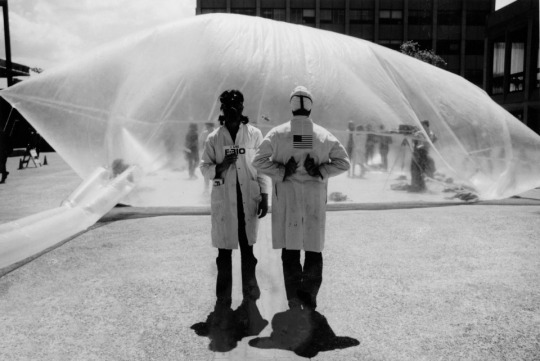
In their last years Ant Farm upgraded its research to seek a harmonious co-existence and co evolution between humans and the natural world, and it led them to the Dolphin Embassy. A project that was formed around a new floatable structure that was self-sustainable and that permitted interspecies communication to promote a campaign of equality between dolphins and human.


While reading the book, which presents many astonishing artists, I found more adequate to my research, Tomas Saraceno and A12. The former was inspired by Richard Buckminster Fuller, who was a visionary architect. Fuller used to invent and plan utopic habitable domes that, could cover kilometres of land by shielding entire buildings, however his ideas got even more surrealistic and visionary with the project Cloud Nine.
Cloud Nine promoted airborne spherical cities to float above land, and they were great examples of “dymaxion”, a term that Fuller coined himself: a dymaxion is a structure which has reached the dynamic maximum tension, which is a principle that strives for the adaptability of structures to different environments while using sustainable resources and energies. (2009: 72)
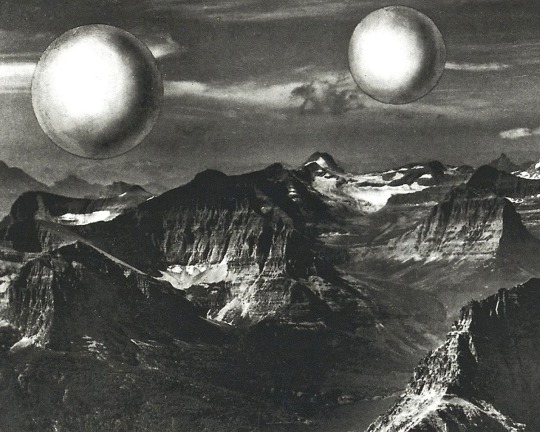
Tomas Saraceno has then taken this concept and applied it to his “Airport City” a utopian modulator flying cell of airborne bubbles that use solar energy to float in the atmosphere. This agglomeration of cells is meant to represent a city that goes beyond the urban sprawl and satisfies the principles of Yona Friedman Spatial City and Soleri’s three dimensional urban spaces. (2009: 200)


As I mentioned, the work of A12 also got my attention. A12 is an Italian collective founded in 1993 in Genoa. I am particularly interested in how their art revolves around architecture and how they studied the transformation of cities and the green areas within them. A12 created contemplative zones within urban spaces, in which nature is re-imagined and then integrated in the city walls. For the Venice Biennale A12 set a temporary pavilion adorned with vegetation and surrounded by red walls and pavement. (2009: 32)
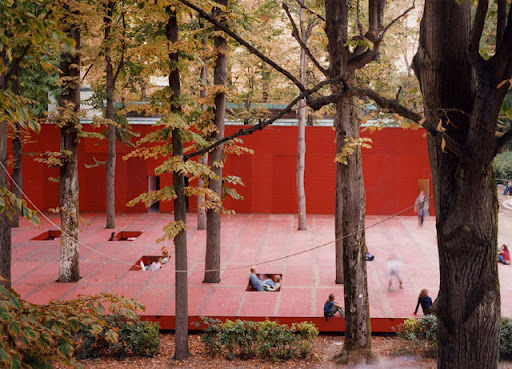
Their project reminded me of what Mabey was writing in his book: “Cities should be bursting with trees; they should surround every drab playing field and rubbish dump. They should line roads and range along the middles of dual carriage ways”. (1973:99)
Richard Mabey explores parks and garden as representative of a sort of urban countryside. Both parks and garden are “deliberate attempts” at creating an image of country within the city. The author, however, criticize the rigor and tidiness that is characteristic of many parks.
“The trees, If the pruned and emaciated shrubs that are planted in these places can be called trees, march on lines as regular as if they were in a nursery. The natural world, mercifully, does not work by rules as rigid and soulless as these - and which even we, as biological creatures ourselves at heart, go out into the countryside to escape. Birds sing in the warm weather and work hard for food in the cold. Flowers open their petals up altogether when the sky is overcast. Neither hunting foxes nor migrating birds have any respect for night-time curfews. Nor does anything in nature grow in straight lines. A bank of wildflowers will gush forward in one place, cower in a second and rocket inexplicably towards the heavens in a third. A man is no different. Ask him to walk in as straight line as he can muster between two landmarks in a grassy meadow, and the track he leaves will be as softly curved as a bend in a stream. There is no need for these life reflecting qualities in a park. A park managed like this is little more than an estate where the building materials just happen to be living, forcibly kept in a state of permanent hibernation.” (1973: 88)
According to Mabey, parks and their wildlife should follow their natural course so that natural and animal species can proliferate as would happen in a forest or countryside. If parks are exuberantly well kept, their trees’ leaves swept rigorously and wildflowers eradicated, then parks are reduced to mere aesthetical areas and they become another artificial segment of the city, underlining the growing distance between men and the natural world.
Reference
Mabey, R. (1973) The unofficial countryside. London: Collins.
Radical nature : art and architecture for a changing planet 1969-2009. (2009). London: Barbican Art Gallery/Koenig Books
Presentation:
https://livemdxac-my.sharepoint.com/:p:/g/personal/sd1513_live_mdx_ac_uk/ETpORJ0bbpFBoYgWzCqlNVwBGjZ2kU913qtiIDU_kvBa8w?email=L.White%40mdx.ac.uk&e=0i3edw
0 notes
Text

From Food for Free by Richard Mabey, This page did not have an illustration credit. Interested in the visualisation and categorisation of real living things and objects and how this can be used to make fiction seem more real? This is a hard magic vs Soft magic argument.
Systems within fictional works totally explained, versus left to interpretation. Maybe a sort of middle ground, Records once whole but now damaged or corrupted that veils some or most of the knowlege but hints at somethings ongoing existence nad also at an alien visual culture
0 notes
Text
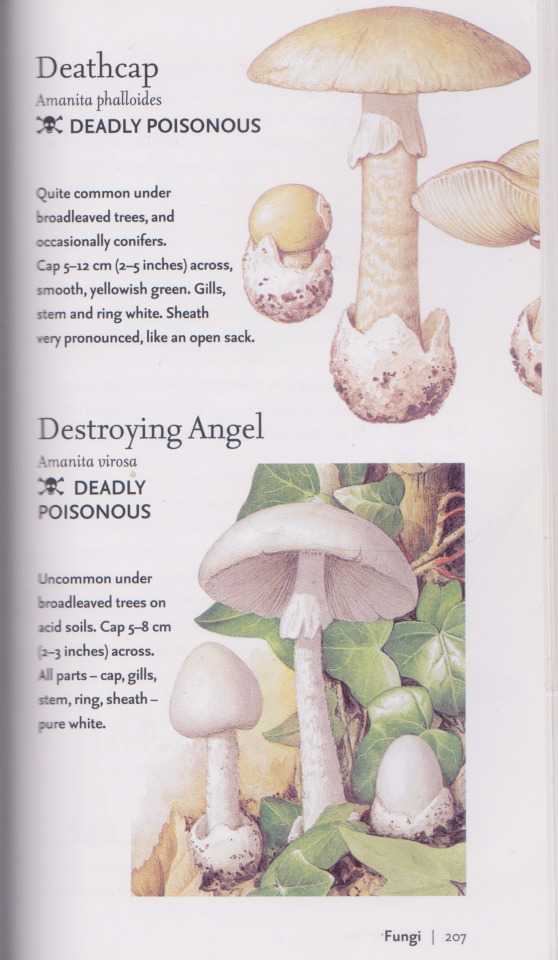
From Food for Free by Richard Mabey, This page did not have an illustration credit. Interested in the visualisation and categorisation of real living things and objects and how this can be used to make fiction seem more real? This is a hard magic vs Soft magic argument.
Systems within fictional works totally explained, versus left to interpretation. Maybe a sort of middle ground, Records once whole but now damaged or corrupted that veils some or most of the knowlege but hints at somethings ongoing existence nad also at an alien visual culture
0 notes
Text
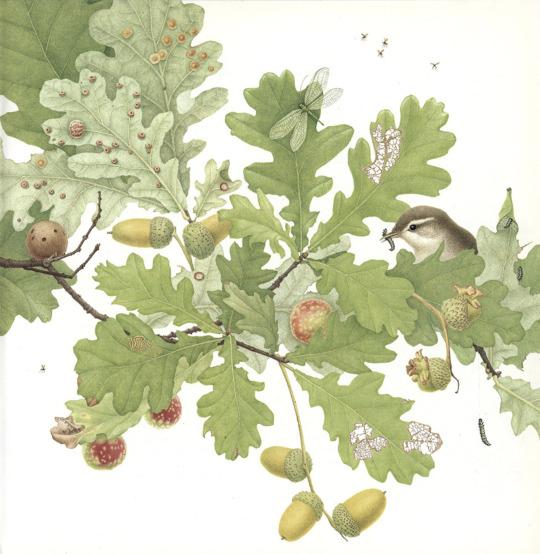
OAK & COMPANY - written by RICHARD MABEY illustrated by CLARE ROBERTS
109 notes
·
View notes